As cold weather draws near every autumn, you may find yourself shopping for cozy, warm clothing. French terry and fleece both provide lots of cozy comfort and make most of the loungewear you see for sale today. So when you compare french terry vs fleece, how do you know which fabric to choose?
The main difference between french terry and fleece is that french terry has fuzzy loops on the back of the fabric, while fleece has a velvety nap caused by cutting the threads on the back of the cloth. Both french terry and fleece are knit fabric with a smooth, knitted top side. Both types of material make comfortable and warm loungewear.
In this article, you will learn the key differences between french terry and fleece, such as which material offers more warmth. You will find a comparison of french terry and fleece hoodies. Finally, you will discover how french terry compares to other fabrics such as velour.
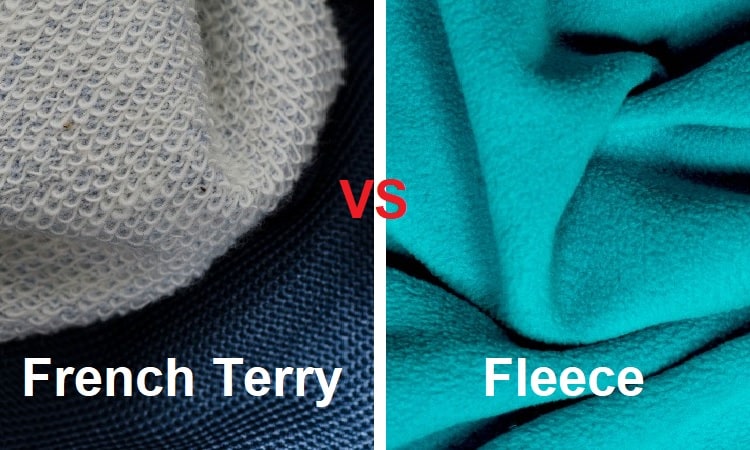
Quick Navigation
- French Terry vs Fleece: Key Points
- What is French Terry Fabric?
- What is Fleece?
- What is the Difference Between French Terry and Fleece?
- Pros and Cons of French Terry Material
- Pros and Cons of Fleece
- What Is French Terry Cotton?
- Is French Terry Cloth Good for Winter?
- French Terry vs Fleece Hoodie
- French Terry vs Other Fabric
- Is Fleece or French Terry Better?
French Terry vs Fleece: Key Points
If you don’t have time to learn about the differences between french terry and fleece in great detail, just take a look at this quick comparison chart!
| French Terry | Fleece | |
|---|---|---|
| Warmth | Warm but only a midweight fabric | Very warm and often a heavy-weight fabric |
| Softness | Very soft | Very soft |
| Stretch | Limited four-way stretch | Generous four-way stretch |
| Moisture Wicking | Excellent | Poor |
| Durability | Good | Excellent |
| Weight | Midweight | Usually heavyweight |
| Ease of Care | Very easy | Very easy |
| Cost | Slightly higher | Slightly lower |
| Uses | More versatile, and can work for summer or winter loungewear | Loungewear and outerwear for cold weather |
What is French Terry Fabric?
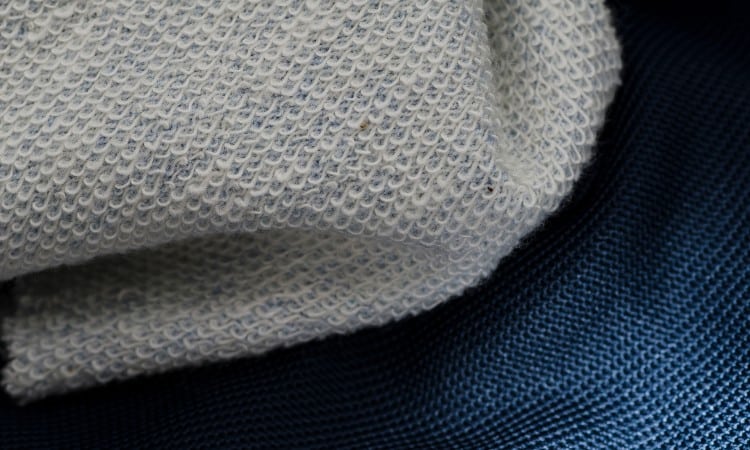
French terry fabric is a knit material with one smooth side and one soft, plush side with a pile made from tiny loops of thread. The top side of french terry will look like t-shirt fabric as this material uses the same cotton knit method as jersey knit, except that it leaves loops of thread loose on the backside of the fabric. These thin, soft loops turn the knit material into a soft and warm cloth perfect for many types of loungewear.
Is french terry good quality? Traditionally, french terry contains 100% cotton fibers, making it a slightly more expensive but good quality material. The cotton makes it very breathable and soft.
Another reason you will find this plush fabric so comfortable because it stretches quite easily. Knit fabrics use a series of interlocked thread loops instead of crisscrossing over-under patterns of threads. The knitted loops create more give in the material, making french terry nice and flexible!
So, where can you expect to find french terry cloth in your wardrobe? This midweight fabric does not appear in outwear like coats and jackets. Instead, look for it in hoodies, sweats, warm t-shirts, and bathrobes.
What is Fleece?
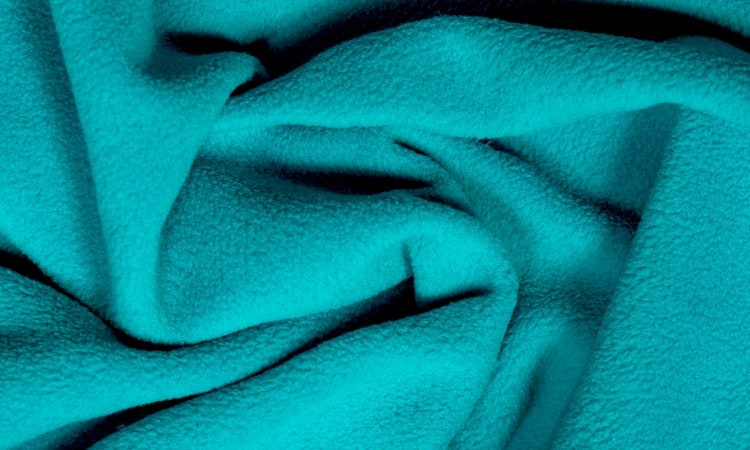
You can find several different kinds of fleece available today, but one of the most popular is sweatshirt fleece. Sweatshirt fleece has a smooth, knitted top side and a velvety backside created by leaving tiny loops of thread loose in the back of the cloth. But the key final step in sweatshirt fleece production is that a special tool slices away the tops of the tiny loops of thread, leaving a soft, velvet layer of fuzz on the back of the material.
Most of the sweatshirts and sweatpants you own probably contain sweatshirt fleece. This very warm fabric is often made out of cheaper synthetic materials like polyester, though you can also find 100% cotton sweatshirt fleece or a blend of the two materials.
Both because it often contains polyester and its fuzzy underside, sweatshirt fleece does not offer great breathability. But it is one of the warmest types of fabric you can find for casual loungewear!
Hoodie fleece can come in varying weights, but usually, it comes in a heavyweight thickness. You have probably grabbed a hoodie for a quick run to the store in the fall on numerous occasions! You can wear sweatshirt fleece in outerwear or cozy around-the-house wear like sweatpants.
What is the Difference Between French Terry and Fleece?
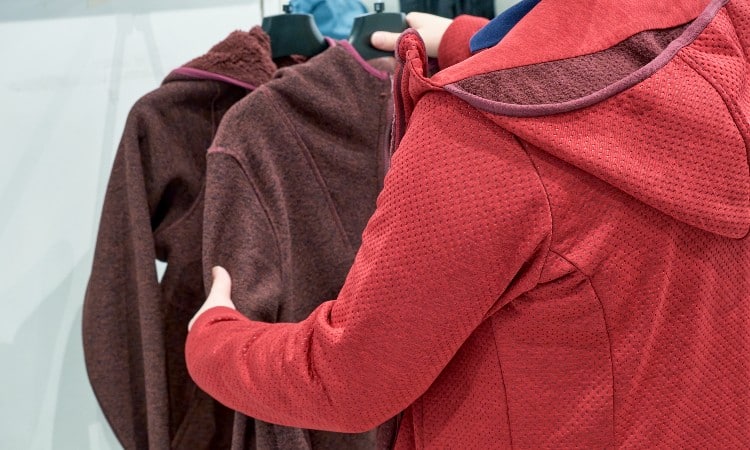
The biggest difference between french terry and fleece is that french terry keeps closed loops of thread on the reverse side of the fabric, while sweatshirt fleece slices through the loops to create a fuzzy reverse side.
That said, both french terry and sweatshirt fleece remain some of the most popular fabrics for use in loungewear. Both have an extreme softness and provide lots of comfort, though they sometimes show up in different kinds of clothing.
Warmth
Which is warmer, french terry or fleece? While both types of cloth will keep you cozy, hoodie fleece is usually a heavyweight, thicker, and more warm material. Sweatshirt fleece also does not have great breathability, meaning that it traps hot air against your skin as you wear it.
On the other hand, french terry usually comes in a lighter-weight material and has great breathability. The thousands of tiny cotton-thread loops on the back of the cloth provide moisture-wicking and can regulate your temperature as you walk or jog.
French terry also often uses a slightly more open knitted structure than the closed construction of knitted fleece. This makes it lighter and less warm than fleece as well. French terry is a cozy midweight fabric that does provide warmth, but it is also a more cooling fabric than sweatshirt fleece.
Softness
Both french terry and fleece have a super soft reverse side. On french terry, this comes from millions of almost-invisible loops of cotton thread, while in fleece, it comes from a fuzzy layer of cut threads that create a velvety or flannel-like nap.
So, which fabric feels softer to the touch? This depends on several factors. The cut-off threads on the reverse side of the hoodie fleece can have a more velvety feel than the loops of thread on french terry. But french terry usually contains cotton, which tends to feel much softer than the polyester that is often used in hoodie fleece.
Either way, you will find that both french terry and sweatshirt fleece feels super soft and comfortable!
Stretch
Sweatshirt fleece and french terry both provide four-way stretch, meaning that the fabric can stretch horizontally and vertically. That said, sweatshirt fleece stretches an equal amount both horizontally and vertically, and french terry stretches more easily horizontally.
This means that sweatshirt fleece does provide a bit more stretch than french terry. But both fabrics have a nice, easy give that makes them comfortable for loungewear.
This can vary, though, because cloth manufacturers often include a tiny bit of elastic in both sweatshirt fleece and french terry. The addition of elastic fibers like elastane, spandex, or lycra will add more stretch to the material!
Moisture-Wicking
French terry offers pretty good moisture-wicking abilities, but sweatshirt fleece does not provide much moisture-wicking ability at all. This may seem odd given how similar these two fabrics are in other ways!
French terry has a leg up in this category because it has all those closed loops on its reverse side. The cotton loops can quickly suck up moisture, and the looser, more open knit on the outer side of the fabric will allow airflow and evaporation.
Sweatshirt fleece, in contrast, has lots of hot polyester fuzz for an inner layer. It also has a thicker, more closed-knit structure for the outside of the fabric. It does not allow much airflow and does not easily wick away moisture. The benefit of this is that sweatshirt fleece will keep you much warmer, but you probably do not want to wear it during a workout!
Durability
Sweatshirt fleece usually has a bit more durability than french terry. Both fabrics will hold up well in the long term, though!
But french terry can occasionally snag in the wash because of all those tiny loops on its reverse side. Plus, it contains cotton, which will wear out more quickly than polyester.
In general, you can expect both sweatshirt fleece and french terry to remain nice for about as long as a jersey knit t-shirt. With proper care, they should last for years!
Weight
Generally speaking, french terry comes in a midweight fabric, while sweatshirt fleece is considered heavyweight. More technically speaking, most fabric or garments will provide a specific weight given in GSM or grams per square meter.
This matters more for sweatshirt fleece. You can get hoodies that you would wear in place of a t-shirt, with super-lightweight hoodie fleece with a GSM of around 200. Or you can buy thick, very heavyweight hoodies that you can wear out in the snow in place of a coat, with a GSM of over 400! This is because sweatshirt fleece can vary a lot in its weight.
On the other hand, French terry almost always comes in that classic midweight thickness, perfect for wearing around the house but not suitable for outdoor wear during very cold weather.
Ease of Care
Both sweatshirt fleece and french terry allow for fairly easy care. You should always wash both fabric types in cold water to avoid shrinking or skewing the knit fabric. Turning the garments inside out will also help protect the shape of your clothing.
You will want to use a gentle detergent with this kind of clothing. Finally, air-dry these garments if you can, If not, put them in the dryer on tumble dry with no heat.
The flexible knitted structure of these materials will help prevent wrinkles, so you do not have to worry about ironing or steaming at all!
Cost
French terry garments often cost more than clothing made of sweatshirt fleece. Of course, the cost of clothing always varies based on things like the brand and the size of the garment. But in general, french terry will cost more because it usually contains cotton, which costs more to produce than polyester.
On top of this, french terry can get expensive depending on the kind of cotton used in it. Some luxury versions of french terry use Turkish combed yarn, a way of manufacturing cotton that creates a very soft and absorbent texture.
Regular ring-spun or open-ended cotton yarns will cost less but won’t have that ultra-luxurious feel.
Uses
Though french terry and sweatshirt fleece both make great loungewear, they do have some different uses as well.
Sweatshirt fleece will keep you warm all winter long in hoodies, jackets, and pullovers. Very heavyweight fleece makes hoodies so thick and warm that you can often wear them in place of a coat! That said, you usually do not want to wear a hoodie in the middle of the summer.
What can you make with French terry? Whether you like to sew your own clothes or you just want to go shopping for french terry clothes, this fabric makes great winter and summer loungewear. It is popular for swimwear cover-ups because it is breathable and absorbent, and it is popular for loungewear because it is warm and stretchy!
Pros and Cons of French Terry Material
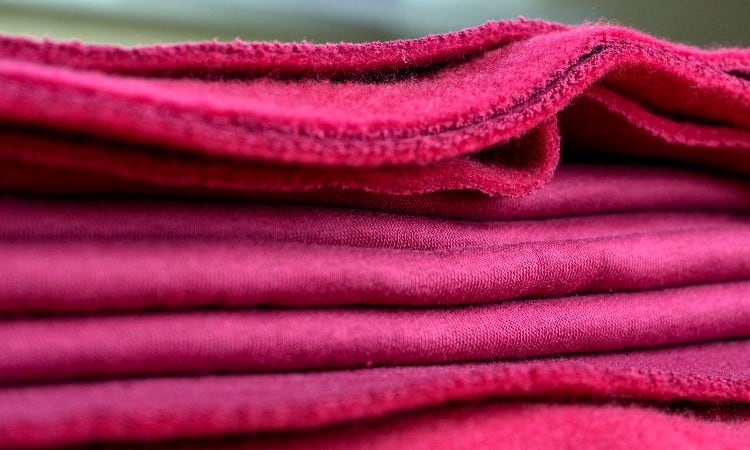
French terry is a lovely and comfortable material, but it does have some pros and cons like all fabrics.
Pros:
- Very soft
- Breathable and moisture-wicking due to its looser knit construction and the cotton loops on its reverse side.
- Comfortable for warm or cool weather, and makes popular swim cover-ups as well as cold-weather loungewear.
- Allows for easy care and will not wrinkle because of its stretchy knit construction.
Cons:
- Can get quite expensive depending on the quality of cotton fibers used in the material.
- Not as warm as hoodie fleece and is more suited to indoor wear than outerwear.
- Not quite as stretchy as hoodie fleece, though it does have a limited four-way stretch.
Pros and Cons of Fleece
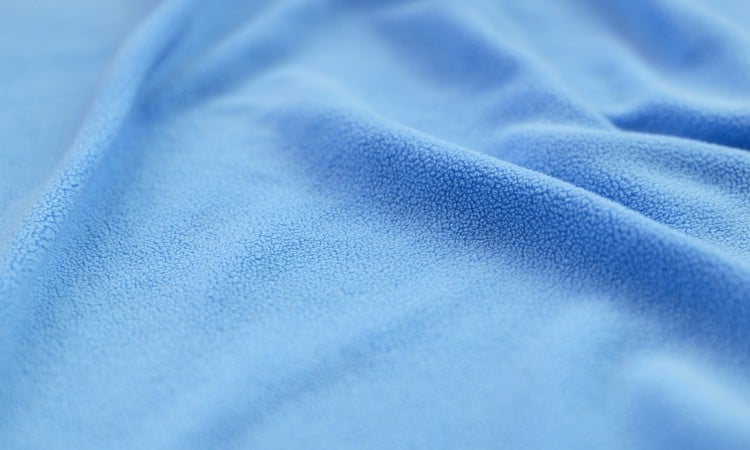
Of course, sweatshirt fleece also has some pros and cons!
Pros:
- Very warm and often comes in thick, heavyweight material.
- Stretches much like t-shirt fabric, with an easy four-way stretch in all directions.
- Has a soft, velvety nap on the inside of the fabric that makes it both warm and soft.
- Usually fairly inexpensive because it contains at least a percentage of polyester fibers in the material.
Cons:
- Though very warm, this fabric does not breathe well and will trap heat and moisture against your skin.
- Not suitable for warm weather wear or working out.
What Is French Terry Cotton?
 French terry cotton is just another name for french terry fabric. French terry almost always contains 100% cotton, though you will sometimes see a small fraction of elastic fibers blended into the material as well.
French terry cotton is just another name for french terry fabric. French terry almost always contains 100% cotton, though you will sometimes see a small fraction of elastic fibers blended into the material as well.
That said, you should always read the product description thoroughly. In some cases, manufacturers do sneak in some polyester into the fabric as well! This takes away from the absorption and breathability of the french terry, so you should keep an eye out for that.
French terry made of cotton has much better softness, moisture-wicking, and absorption than any version containing synthetic fibers.
Is French Terry Cloth Good for Winter?
French terry cloth is a mid-weight material that will keep you warm indoors during the winter. You would not want to wear it outside in place of a winter coat, though! You can think of french terry as warmer than a regular t-shirt, but not as warm as a winter coat.
On the flip side of that coin, is french terry too hot for summer? That depends. French terry makes great swim cover-ups and can feel comfortable in the summer because it is so breathable. But it is heavier than a t-shirt or the average button-down shirt, so you may find it too warm for jogging or walking outside in the summer.
French Terry vs Fleece Hoodie
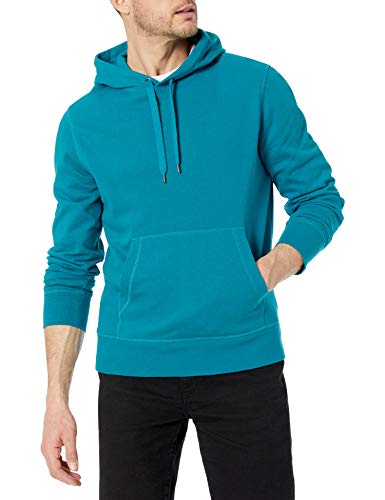 Both french terry and sweatshirt fleece make popular loungewear, but which fabric makes the best hoodie? This is the big question!
Both french terry and sweatshirt fleece make popular loungewear, but which fabric makes the best hoodie? This is the big question!
For the past several decades, hoodies have taken over as one of the most popular and comfortable kinds of clothing on the market, only slightly less popular than the t-shirt!
Both types of fabric make great hoodies. But french terry hoodies will usually not keep you quite as warm, while fleece hoodies may feel suffocating due to lack of breathability.
The best way to choose between these two types of hoodies is to ask yourself if you want to feel warmer or cooler. For a warmer feel, choose fleece. For a cooler feel, choose french terry!
You should also definitely look into the weight of the material before making a purchase. Remember that both french terry and fleece come in varying GSM, meaning that you can get warmer or cooler garments based on the thickness of the fabric, as well!
French Terry vs Other Fabric
How does french terry compare to other similar types of fabric? Despite its popularity in loungewear, french terry remains under the radar for many people. Possibly this happens because it is easy to confuse this fabric with other types of material, like terry cloth.
Is French Terry Like Velour?
French terry and velour have many of the same uses in clothing but use a different type of fabric construction. French terry is a knit fabric with loops of loose cotton thread on the reverse side. Velour is made using satin or plain weave of crisscrossing threads, with a soft pile made by slicing across the loops of thread on the reverse side of the material.
Velour typically contains elastic fibers and has a very stretchy feel. However, it doesn’t absorb moisture as well as french terry. You might think of velour as “fake velvet” because it does look quite velvety.
Both materials are popular for bathrobes and loungewear.
French Terry Vs Cotton
French terry is usually made out of cotton fibers. Cotton remains one of the most popular materials in the world for making many different types of material, including french terry, denim, and jersey knit.
French terry is one of the warmest and softest kinds of material made out of cotton, though. You will find it just ass stretchy as t-shirt jersey-knit cotton and even softer and warmer than the plain weave kind of cotton you would find in bedsheets.
French Terry Vs Terry Cloth
French terry and terry cloth fabrics have several key differences, including the overall construction of the fabric. Unlike the knit structure in french terry, terry cloth does use an over-under weaving pattern, though it features something special called a two-warp beam weave that allows it to create lots of loose loops of thread on both sides of the material. Because of this, terry cloth is one of the most absorbent fabrics available.
Almost all towels and washcloths are made out of terry cloth! This fabric used to always contain cotton, but these days, you can also find it made out of cheaper polyester.
Is Fleece or French Terry Better?
Whether or not fleece or french terry is better for you depends on the kind of garment you want. French terry makes great loungewear for the winter and summer and makes popular bathrobes. Sweatshirt fleece will keep you warm inside and outside during the winter and feels super soft as well!
If you want something you can wear in the summer, wear during a workout, or wear after a bath, you probably want to go with french terry. If you want something that has a thick weave to block cold wind or a soft feel for a midwinter nap, you may want a sweatshirt fleece instead! Also, french terry usually costs a bit more than sweatshirt fleece, so you prefer to go with hoodie fleece if you have a limited budget.
Have you ever tried wearing a french terry hoodie and then a fleece hoodie? Which one did you like better? Leave a comment below to let us know!